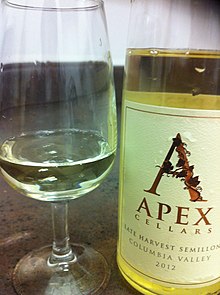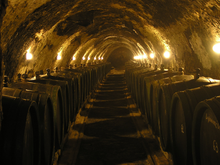
Dessert wines, sometimes called pudding wines in the United Kingdom, are sweet wines typically served with dessert.

Sauvignon blanc is a green-skinned grape variety that originates from the city of Bordeaux in France. The grape most likely gets its name from the French words sauvage ("wild") and blanc ("white") due to its early origins as an indigenous grape in South West France. It is possibly a descendant of Savagnin. Sauvignon blanc is planted in many of the world's wine regions, producing a crisp, dry, and refreshing white varietal wine. The grape is also a component of the famous dessert wines from Sauternes and Barsac. Sauvignon blanc is widely cultivated in France, Chile, Romania, Canada, Australia, New Zealand, South Africa, Bulgaria, the states of Oregon, Washington, and California in the US. Some New World Sauvignon blancs, particularly from California, may also be called "Fumé Blanc", a marketing term coined by Robert Mondavi in reference to Pouilly-Fumé.

Riesling is a white grape variety that originated in the Rhine region. Riesling is an aromatic grape variety displaying flowery, almost perfumed, aromas as well as high acidity. It is used to make dry, semi-sweet, sweet, and sparkling white wines. Riesling wines are usually varietally pure and are seldom oaked. As of 2004, Riesling was estimated to be the world's 20th most grown variety at 48,700 hectares, but in terms of importance for quality wines, it is usually included in the "top three" white wine varieties together with Chardonnay and Sauvignon blanc. Riesling is a variety that is highly "terroir-expressive", meaning that the character of Riesling wines is greatly influenced by the wine's place of origin.
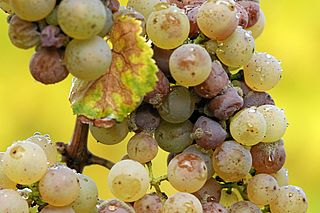
Noble rot is the beneficial form of a grey fungus, Botrytis cinerea, affecting wine grapes. Infestation by Botrytis requires moist conditions, but if the weather stays wet, the damaging form, "grey rot", can destroy crops of grapes. Grapes typically become infected with Botrytis when they are ripe. If they are then exposed to drier conditions and become partially raisined, this form of infection is known as noble rot. Grapes picked at a certain point during infestation can produce particularly fine and concentrated sweet wine. Wines produced by this method are known as botrytized wines.
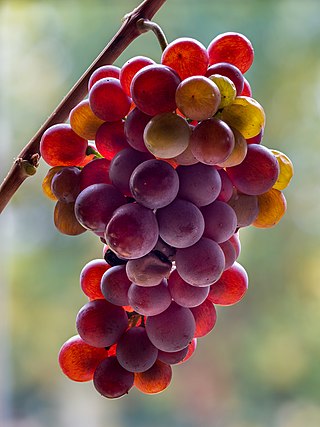
Pinot Gris, Pinot Grigio or Grauburgunder is a white wine grape variety of the species Vitis vinifera. Thought to be a mutant clone of the Pinot Noir variety, it normally has a grayish-blue fruit, accounting for its name, but the grapes can have a brownish pink to black and even white appearance. The word pinot could have been given to it because the grapes grow in small pinecone-shaped clusters. The wines produced from this grape also vary in color from a deep golden yellow to copper and even a light shade of pink, and it is one of the more popular grapes for skin-contact wine.

Viognier is a white wine grape variety. It is the only permitted grape for the French wine Condrieu in the Rhône Valley.

Oak is used in winemaking to vary the color, flavor, tannin profile and texture of wine. It can be introduced in the form of a barrel during the fermentation or aging periods, or as free-floating chips or staves added to wine fermented in a vessel like stainless steel. Oak barrels can impart other qualities to wine through evaporation and low level exposure to oxygen.

Chaptalization is the process of adding sugar to unfermented grape must in order to increase the alcohol content after fermentation. The technique is named after its developer, the French chemist Jean-Antoine-Claude Chaptal. This process is not intended to make the wine sweeter, but rather to provide more sugar for the yeast to ferment into alcohol.

Graves is an important subregion of the Bordeaux wine region. Graves is situated on the left bank of the Garonne River, in the upstream part of the region, southeast of the city Bordeaux and stretches over 50 kilometres (31 mi). Graves is the only Bordeaux subregion which is famed for all three of Bordeaux' three main wine types—reds, dry whites and sweet wines—although red wines dominate the total production. Graves AOC is also the name of one Appellation d'origine contrôlée (AOC) which covers most, but not all of the Graves subregion.

Agiorgitiko is a red Greek wine grape variety that, as of 2012, was the most widely planted red grape variety in Greece, ahead of Xynomavro. The grape has traditionally been grown in the Nemea region of the Peloponnese but can be found throughout the country including Attikí (Attica) and Makedonía (Macedonia).
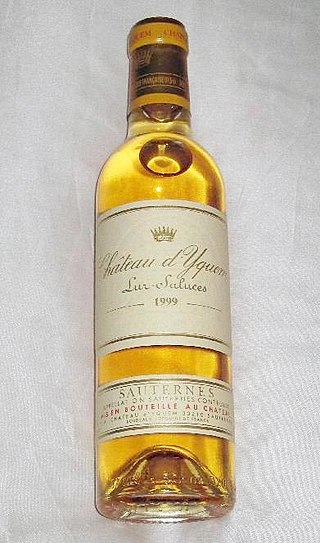
Sauternes is a French sweet wine from the region of the same name in the Graves section in Bordeaux. Sauternes wine is made from Sémillon, sauvignon blanc, and muscadelle grapes that have been affected by Botrytis cinerea, also known as noble rot. This causes the grapes to become partially raisined, resulting in concentrated and distinctively flavored wines. Due to its climate, Sauternes is one of the few wine regions where infection with noble rot is a frequent occurrence. Even so, production is a hit-or-miss proposition, with widely varying harvests from vintage to vintage. Wines from Sauternes, especially the Premier Cru Supérieur estate Château d'Yquem, can be very expensive, largely due to the very high cost of production. Barsac lies within Sauternes and is entitled to use either name. Somewhat similar but less expensive and typically less-distinguished wines are produced in the neighboring regions of Monbazillac, Cérons, Loupiac and Cadillac. In the United States, there is a semi-generic label for sweet white dessert wines known as sauterne without the "s" at the end and uncapitalized.

Languedoc-Roussillon wine, including the vin de pays labeled Vin de Pays d'Oc, is produced in southern France. While "Languedoc" can refer to a specific historic region of France and Northern Catalonia, usage since the 20th century has primarily referred to the northern part of the Languedoc-Roussillon region of France, an area which spans the Mediterranean coastline from the French border with Spain to the region of Provence. The area has around 700,000 acres (2,800 km2) under vines and is the single biggest wine-producing region in the world, being responsible for more than a third of France's total wine production. In 2001, the region produced more wine than the United States.
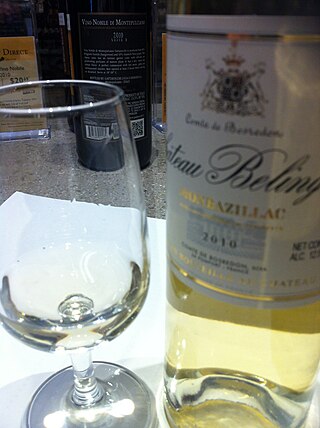
Monbazillac is an Appellation d'Origine Contrôlée (AOC) for sweet white wine produced in the village of Monbazillac on the left bank of the Dordogne just across from the town of Bergerac in South West France. The appellation covers almost 2,000 hectares of vineyards.

Vouvray is a French wine region in the Loire Valley located in the Touraine district just east of the city of Tours in the commune of Vouvray. The Appellation d'origine contrôlée (AOC) is dedicated almost exclusively to Chenin blanc; the obscure and minor grape Arbois is permitted but rarely used.
The classification of wine is based on various criteria including place of origin or appellation, vinification method and style, sweetness and vintage, and the grape variety or varieties used. Practices vary in different countries and regions of origin, and many practices have varied over time. Some classifications enjoy official protection by being part of the wine law in their country of origin, while others have been created by, for example, growers' organizations without such protection.

The wine regions of Bordeaux are a large number of wine growing areas, differing widely in size and sometimes overlapping, which lie within the overarching wine region of Bordeaux, centred on the city of Bordeaux and covering the whole area of the Gironde department of Aquitaine.

The harvesting of wine grapes (Vintage) is one of the most crucial steps in the process of wine-making. The time of harvest is determined primarily by the ripeness of the grape as measured by sugar, acid and tannin levels with winemakers basing their decision to pick based on the style of wine they wish to produce. The weather can also shape the timetable of harvesting with the threat of heat, rain, hail, and frost which can damage the grapes and bring about various vine diseases. In addition to determining the time of the harvest, winemakers and vineyard owners must also determine whether to use hand pickers or mechanical harvesters. The harvest season typically falls between August & October in the Northern Hemisphere and February & April in the Southern Hemisphere. With various climate conditions, grape varieties, and wine styles the harvesting of grapes could happen in every month of the calendar year somewhere in the world. In the New World it is often referred to as the crush.

Vespaiola is a white Italian wine grape variety planted primarily in the Veneto region of northeastern Italy, where it is often dried to produce passito style dessert wines. Along with Friulano, Vespaiola is an important component in the Denominazione di origine controllata (DOC) white wine of Breganze produced in the province of Vicenza.

Anjou wine is produced in the Loire Valley wine region of France near the city of Angers. The wines of region are often grouped together with the wines of nearby Saumur as "Anjou-Saumur". Along with the wines produced further east in Touraine, Anjou-Saumur make what is collectively known as the "Middle Loire" (as opposed to the "Upper Loire" which includes the wine regions of Sancerre and Pouilly-Fumé. Within the Anjou wine region are several Appellation d'origine contrôlées responsible for a broad spectrum of wines including still red, white and rosé produced with varying levels of sweetness. Extending across the Deux-Sèvres, Maine-et-Loire and Vienne départements, the generic Anjou AOC appellation and its various sub-appellations encompasses vineyards across more than 151 communes.

The Barossa Valley wine region is one of Australia's oldest and most premier wine regions. Located in South Australia, the Barossa Valley is about 56 km northeast of the city of Adelaide. Unlike most of Australia whose wine industry was heavily influenced by the British, the wine industry of the Barossa Valley was founded by German settlers fleeing persecution from the Prussian province of Silesia. The warm continental climate of the region promoted the production of very ripe grapes that was the linchpin of the early Australian fortified wine industry. As the modern Australian wine industry shifted towards red table wines in the mid-20th century, the Barossa Valley fell out of favor due to its reputation for being largely a Syrah from producers whose grapes were destined for blending. During this period the name "Barossa Valley" rarely appeared on wine labels. In the 1980s, the emergence of several boutique families specializing in old vine Shiraz wines began to capture international attention for the distinctive style of Barossa Shiraz, a full bodied red wine with rich chocolate and spice notes. This led to a renaissance in the Barossa Valley which catapulted the region to the forefront of the Australian wine industry.
